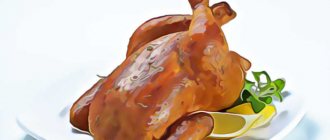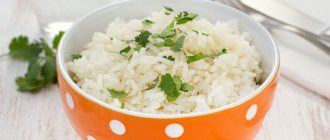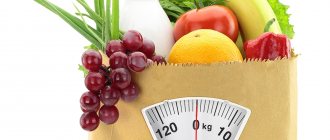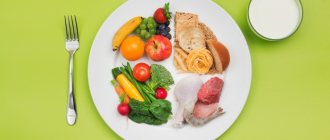This was primarily due to the high glycemic index of this vegetable.
Today, renowned nutritionists have rehabilitated this root vegetable.
Moreover, the phrase “lose weight by eating potatoes” no longer belongs to the realm of science fiction. The main thing is to know how to do it correctly.
Nutritional value of potatoes
The chemical composition of potatoes per 100 g of product is characterized by a high content of carbohydrates (16 g) and a moderate amount of protein (2 g), fat (0.4 g) and dietary fiber (1.4 g). The remaining 80 g is water.
In addition to these compounds, root vegetables contain vitamins: B₁, B₆, B₂, H, PP, C and E. Potatoes contain many macro- and microelements, such as:
- potassium;
- phosphorus;
- sulfur;
- chlorine;
- magnesium;
- calcium;
- fluorine;
- vanadium;
- iodine;
- zinc;
- iron;
- molybdenum;
- cobalt;
- nickel;
- copper.
Potatoes are a source of folic, oxalic and pantothenic acid, as well as phospholipids - compounds necessary to fight cholesterol.
Be sure to see: Is it possible to eat corn while on a diet: benefits and harms? Get a complete set of proteins, fats and carbohydrates from Doshirak dietary products on a diet: is it possible to eat fast food products? Is it possible to eat soy sauce while on a diet: all the myths and truth
Potato-eating peoples: Irish
Potatoes were introduced to Ireland in the 17th century. It took root well in the cool temperate climate and bore fruit much better than any other crop. In the early 18th century, potatoes were the main source of energy, especially for the poor. In 1839, the average worker in Ireland got 87% of his calories from potatoes (). In 1845, there was a massive infection of potatoes with late blight, which led to the devastation of plantations throughout the country and the Great Famine.
We have no reliable data on the health of the Irish before the famine, other than reports of vitamin A deficiency (). At the same time, the fertility rate (ability to conceive) among the Irish was high and they were occasionally described as healthy and attractive (). It is likely that the high nutritional value of the potato diet may have played a role in this, but we have too little evidence. Adam Smith's famous dictum that potatoes are "especially suited to the sound human constitution" can be supported by many observations by modern researchers, with much the same result.

Effects on the body, benefits and harms when losing weight: why you shouldn’t get carried away

Potatoes are a unique vegetable in many respects. Even grapefruit cannot compare with it in vitamin C content. The fiber in its composition does not cause irritation to the walls of the stomach, so this type of root vegetable can be found on the menu of ulcer sufferers and gastritis sufferers.
Macro- and microelements, such as magnesium, copper, iodine and calcium, contribute to faster removal of fluid from the body, thus preventing swelling.
Plant protein guarantees a long-lasting feeling of fullness, significantly reducing the number of hunger pangs, and dietary fiber and fiber not only have a beneficial effect on the entire gastrointestinal tract system, but also remove toxins, while maintaining normal blood sugar levels.
Considering the large number of positive factors, why can’t you constantly eat potatoes and lose weight? It's all about the way you use it. Most often, potatoes are fried with vegetable or butter or even lard. No less popular are French fries with ketchup, salty chips or baked tubers in a heavy fatty sauce. In such cases, a modest 80 kcal turns into 300 or all 500.
The second disadvantage of this vegetable is its high starch content. When this substance enters the human body under the influence of insulin, it is broken down into simple sugars, which, in turn, are converted into glycogen and adipose tissue of cells. You can get rid of the latter only by combining diet with physical activity.
It is important! To reduce the calorie content of potatoes and reduce the starch content in them, before cooking, you need to fill the tubers with cold water and leave for at least 1-2 hours.
Pros and cons of the potato diet
A diet based on tasty and healthy root vegetables has its advantages. These include the following advantages:
- Potatoes give a long-lasting feeling of fullness, so a person will not feel very hungry
- this root vegetable has a positive effect on the nervous system, especially if a person has been stressed or depressed for a long time
- During such a diet, physical weakness and general apathy are not observed
- Considering that potatoes are an inexpensive product, such a diet will be quite budget-friendly
- This product can be used to prepare different dishes, which will allow you to diversify your diet.
- Potatoes are available at any time of the year, which makes it easier to follow the diet at the right time.
The diet based on this root vegetable is distinguished by its nutritional value and usefulness. However, this diet also has some disadvantages. It is considered quite rigid and limited. During such a diet, it is recommended to additionally take a vitamin and mineral complex.
This diet has some contraindications. These include:
- pregnancy or breastfeeding period
- diabetes, especially in advanced stages
- high blood sugar
- urolithiasis disease
- chronic diseases of the intestinal tract
- serious stomach problems.
On a potato diet, a person will experience extreme thirst. Therefore, before or after the main course, drink a glass of water without gases. Instead of water, you can choose green tea without sugar or kefir with a small percentage of fat.
In what form is it best to eat?

Properly prepared potato dishes can help you achieve your ideal weight. If we consider this issue from the point of view of calorie content, then the most dietary vegetable will be boiled in its jacket.
Its energy value does not exceed 78 kcal/100 g. Next comes stewed root vegetables with an indicator of 102 kcal, then mashed potatoes - 106 kcal, baked in a uniform in foil - 110 kcal and, finally, fried - 195 kcal. The deep-fried product closes the chain, with an indicator of 350-400 kcal.
Potatoes baked in the oven with the skin on will retain the greatest amount of vitamins and nutrients. This is the healthiest dish of all presented. Slightly fewer micro- and macroelements will remain in the boiled vegetable (in its uniform), and their content is even lower in peeled boiled root vegetables. Pan-fried and deep-fried potatoes are not even worth mentioning.
A feeling of fullness comes even when consuming a small portion. In addition, the microelements contained in it remove excess water from the body, helping the kidneys function and preventing the occurrence of edema. The potato diet, due to the presence of starch in the product, should go hand in hand with regular physical activity. So, its efficiency will increase by 1.5-2 times.
During your diet, you should not combine potatoes with animal protein, white rice, or baked goods. Due to the high glycemic index, you should not eat this vegetable at night. When choosing between young and old root crops, preference is given to the former. Firstly, they have a lower calorie content - 60-65 kcal versus 80 kcal of old potatoes. Secondly, in the latter, due to their long shelf life, carbohydrates quickly break down into simple sugars, which are easily converted into the subcutaneous fat layer.
Boiled potatoes and mashed potatoes
Boiled potatoes are one of the simplest and most hassle-free dishes. The vegetable can be cooked peeled or in its jacket. This is a low calorie product, slightly inferior to the baked version.
This is interesting! To preserve vitamins and elements that improve metabolism, potatoes should be placed in boiling, not cold, water during cooking.

During cooking, the root vegetable retains many useful substances, including fiber, which has a beneficial effect on the gastrointestinal tract, as well as kidney function.
One of the most famous dishes made from boiled potatoes is mashed potatoes. This product is considered a safe baby food, so it is also ideal for dietary nutrition.
When introducing this dish into your diet, it is worth remembering that you cannot add full-fat milk and butter to it during the cooking process. Water puree is the lowest calorie option. To improve the taste, you can supplement it with parsley, dill or green onions, and use skim or 1% milk instead of water.
As for spices, when dieting, you must remember that some types of spices can stimulate the appetite. During the period of weight loss, salt consumption should also be minimized, as it retains water in the body.
Fried

Fried potatoes are not recommended for dieting. And the point is not only in its high calorie content (190-200 kcal/100 g), but also in the significant content of carcinogens in this dish. During frying, the product is deprived of most vitamins and beneficial compounds.
Baked
It is potatoes baked in the oven that hold first place in terms of lowest calorie content. The main condition is that the vegetable must be cooked in its peel and without the use of oil. Potato skin contains many useful microelements, including those responsible for detoxification and removal of excess moisture from tissue cells.
Plant proteins albumin and globulin are also not destroyed when baked in foil. They promote quick satiety and maintain this feeling for a long time.
French fries

French fries have long been a symbol of fast food. Which is not at all in his favor.
Fried in a large amount of oil, it has not only the highest calorie content (350-400 kcal), but also a high content of trans fats, which are present in any hydrogenated vegetable oil.
This is the product used in most fast food establishments.
Useful properties of potatoes
A potato diet not only helps to lose weight, but also improves the health of the body, since tubers bring significant benefits to a person when consumed correctly. During the cooking process, up to 70% of the valuable components of the composition are destroyed. Raw potatoes prevent you from losing them. Is it possible to eat potatoes if you have diabetes? The question is quite complex. Vegetables are allowed to be included in the menu on a limited basis and only boiled in their uniforms or completely without heat treatment.
Positive effects of potatoes
- Prevention of atherosclerosis. The components in raw potatoes are highly active against bad cholesterol: they bind it and remove it from the body. Thanks to this, the formation of cholesterol plaques does not occur, and the patency of blood vessels is not impaired.
- Improving kidney, liver and heart function. The mineral components in the tubers make it possible to strengthen organ tissue, cleanse them of harmful substances and prevent the appearance of foci of pathological changes. If you are prone to fluid retention, potatoes will relieve swelling and reduce the load on the heart muscle and blood vessels.
- The high fiber content helps relieve loose bowel syndrome and even constipation. Also, the starch that comes with raw potatoes helps cleanse the intestines of toxins that appear due to slow digestion.
- Juice from raw vegetables for gastritis helps relieve discomfort and significantly improve well-being. It reduces acidity, causing the inflamed mucous membrane to stop experiencing constant irritation. In addition, thanks to the enveloping properties of starch, a protective film is formed on damaged areas of tissue. Under it, they can be restored without the negative impact of food and digestive juice passing through the stomach.
- Restoring proper metabolism. This effect of potatoes is due to the presence of a large amount of potassium in its composition. If hypertension is just beginning to develop, then regularly eating raw potatoes can restore elasticity to the vascular walls and eliminate the problem before it becomes incurable.
- Boosting immunity. There is almost as much vitamin C in one medium tuber as in an orange, but at the same time, potatoes do not have an irritating effect on the stomach. Its regular use helps prevent frequent viral infections and keep the body in good shape.
- High concentration of vitamin A. Retinol is necessary to maintain the beautiful appearance of the skin, its elasticity and sufficient moisture. Also, the component of the composition is responsible for hair health and helps maintain visual acuity.
- In the fight against anemia, potato juice will be very useful. By drinking 120 ml of it before breakfast, lunch and dinner, you can improve your blood composition and get rid of chronic fatigue, which is always present in pathology.
- The juice of tubers can also eliminate vascular spasms, which cause severe headaches. If an attack begins, then, without allowing the moment when the migraine becomes unbearable, you need to drink ¼ glass of potato juice and lie down. Soon the discomfort will pass.
Attention!
To prevent raw potatoes from harming the body, we must remember that you should not eat them in large quantities. Also, you should not eat green or shriveled tubers. If traces of rotting are visible on a potato, it should be thrown away. Only unsprouted and completely healthy vegetables can be eaten raw.
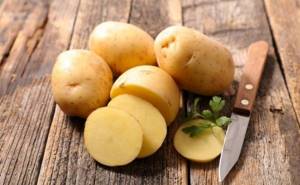
Dietary recipes for healthy eating and weight loss

There are many recipes for potato dishes. Some of them can be safely included in the diet menu.
Baked "like fries"
You will need 3 large potatoes, spices and 1 tbsp. spoon of ground crackers. The vegetables are cut into strips, then placed in a bag and shaken together with spices and breading mixture. Then the potatoes are carefully placed on a baking sheet with parchment and placed in the oven (180°C) for 20-30 minutes.
In a slow cooker
Young potato tubers (700-800 g) are thoroughly washed, dried, pierced several times with a fork, and then wrapped in thick foil. Then the products are placed in a multicooker (up to ¾ of the volume) and baked in the “Baking” mode for 40-60 minutes. Serve potatoes cut into 2 parts with salt, herbs and a small amount of olive oil.
Is it possible to eat raw potatoes?
Raw potatoes are often eagerly gnawed by children during periods of rapid growth. They intuitively feel the lack of minerals in their body and do their best to restore them. You can eat raw potatoes without fear, but little by little, and only if they are not green or spoiled. When the vegetable is well tolerated by the gastrointestinal tract (in some people it causes flatulence, pain due to gases and nausea), then it is allowed to spend a fasting day on potatoes.
A new product should be included in your diet gradually, starting with minimal portions. They are gradually increased to the maximum allowable - 300 g of raw potatoes per day. In a number of effective diets for weight loss, the volume of raw vegetables per day is recommended up to 700 g, but this is still a bit heavy for the intestines.

Unloading and nutrition for emergency weight loss
Potatoes can also be used during fasting days. This mono-diet allows you to lose 500-600 g, provided you drink plenty of water and have your last meal no later than 19:00.
A potato fasting day allows you to introduce baked or boiled potatoes into your diet without salt and oil. The permissible norm is 1.5 kg of product per day. The number of meals should not be less than 5.
The potato-kefir express diet has also proven itself well. To the same diet (1.5 kg) add 600 ml of low-fat kefir, which can be drunk 3 times a day.
Another option for quick weight loss is mashed potatoes. It is prepared from 600 g of product and 1 glass of skim milk. You can eat mashed potatoes for breakfast and lunch; for dinner you should replace it with 2 baked potatoes.
Potato juice deserves special mention, as it can stabilize the water-salt balance and activate digestive processes. When used correctly (100 ml 3 times a day 20 minutes before meals), up to 0.4 kg of excess weight can be lost per day, even without following a diet.
Watch a video about the potato diet:
Dietary potato dishes
Soups, purees, baked, boiled vegetables with lemon juice, herbs are not all healthy food options. Add simple low-calorie potato dishes to your diet.
Potatoes with tomato sauce
- Boil 5 medium potatoes in their jackets, peel them.
- Chop and mix 2 tomatoes, 2-3 cloves of garlic, a bunch of fresh herbs.
- Cut the potatoes into rings and combine with tomato dressing.
- Add black pepper if necessary.
Baked Potatoes with Herbs and Garlic
- Peel and cut 0.5 kg of potatoes.
- Grate 2-3 cloves of garlic and mix with vegetables.
- Transfer to a baking dish. Place in an oven preheated to 200 degrees for half an hour.
- Garnish the finished dish with fresh herbs.
Stewed potatoes
- Peel and wash 1 kg of potatoes, 1 carrot.
- Cut the vegetables into circles, place in a saucepan, cover with water. Place on medium heat.
- After 20 minutes, add the tomato cut into slices. Simmer for another 10 minutes.
- Sprinkle the finished dish with chopped herbs.
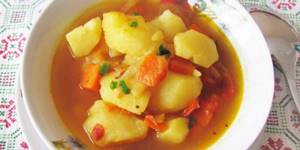
Experts' opinions
Most nutrition experts believe that potatoes can be eaten on a diet. However, this must be done correctly.
Well-known nutritionist Alexey Kovalkov, host of the “Family Size” program, does not require completely abandoning potatoes, but recommends using them correctly: only young and baked.
His colleague Mikhail Ginzburg, MD. Samara Research Institute of Dietetics also speaks about the proper use and benefits of this product. The substances contained in the vegetable not only prolong the feeling of fullness, but also nourish the muscles.
An ardent fan of organic nutrition, actress Julia Roberts also sees nothing wrong with eating potatoes. The basis of her favorite diet is this root vegetable. Her fasting diet, in addition to baked potatoes, includes fresh vegetables and low-fat cottage cheese.
How to replace potatoes on a diet
You can fantasize a lot and talk beautifully about products that can replace potatoes on a diet. There are gastronomic equivalents that are equal in nutritional value and benefits to this vegetable, but no other food compares in taste to hot, aromatic jacket potatoes. Among vegetables, equivalents of potatoes on a diet can be turnips, Jerusalem artichokes, cauliflower, lentils, and celery root. If you want to exclude potatoes from the soup, replace them with one of the cereals - barley, pearl barley, buckwheat.
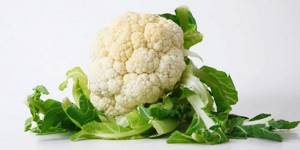
Main conclusions
Potatoes are a controversial product. Despite its glycemic index, it can be used both during the diet and for emergency weight loss:
- In a dietary diet, only young vegetables are used for cooking.
- You should not combine potatoes with animal fats and proteins, heavy sauces and large amounts of vegetable oil.
- The healthiest potato is baked. It retains most nutrients while being low in calories.
- To achieve better results, the potato diet must be combined with physical exercise. In this case, starchy substances are converted into energy, and not into subcutaneous fat.
- Fried dishes from this vegetable are unacceptable on any diet.
Whether potatoes become a friend or an enemy of a figure depends only on the method of its preparation. Proper use of this vegetable will help achieve excellent results without radical deprivation.
Potato-eating peoples: Quechua
The indigenous people of Peru have depended on potatoes for thousands of years. With an average of 3170 kcal per day, up to 74% of calories they received from it, 10% from grain crops, 10% from plants of the genus Chenopodiaceae (quinoa and canihua) and 4% from animal products ().
A 2001 study of Quechua men living in rural areas found that their average body fat percentage was 16.4% (). The average age of the volunteers was 38 years. With age, the percentage of body fat among representatives of this population increased, and, according to forecasts, by the age of 65 it should have reached ±20%. This is well below what would be considered overweight, so most men in this nation are quite slim. A 2004 study of Quechua women living in rural areas found that their average body fat percentage was 31.2% (). The average age of volunteers is 35 years. Among the Quechua who immigrated to Lima, the capital of Peru, the percentage of fat was higher.
Among women living in rural areas, the average fasting insulin level was 6.8 μIU/mL and fasting glucose level was 68.4 mg/dL, which generally indicates good insulin sensitivity and glucose control (). The insulin and glucose levels of rural residents were much lower than those of urban residents. Blood pressure was low in both groups. Overall, this indicates a high incidence of excess weight gain among Quechua women, although to a lesser extent than urban Quechuas who consume less potatoes. I don't think the Quechua diet is optimal, but it does seem to help maintain a certain level of metabolic health.



